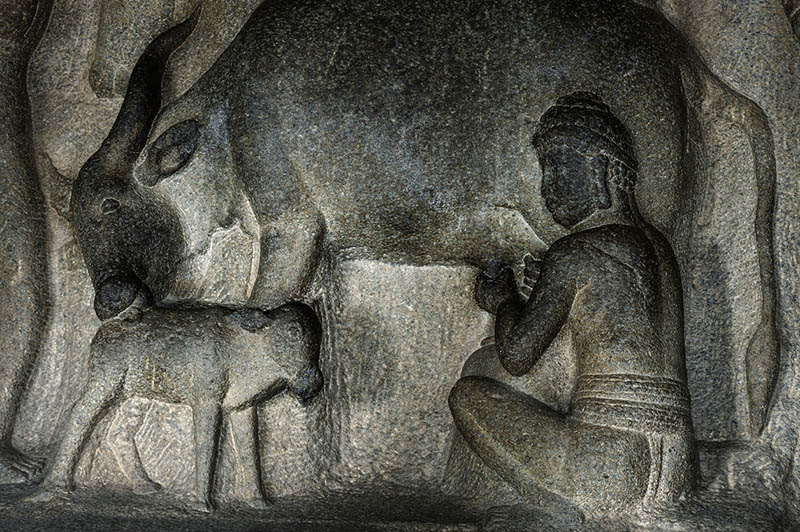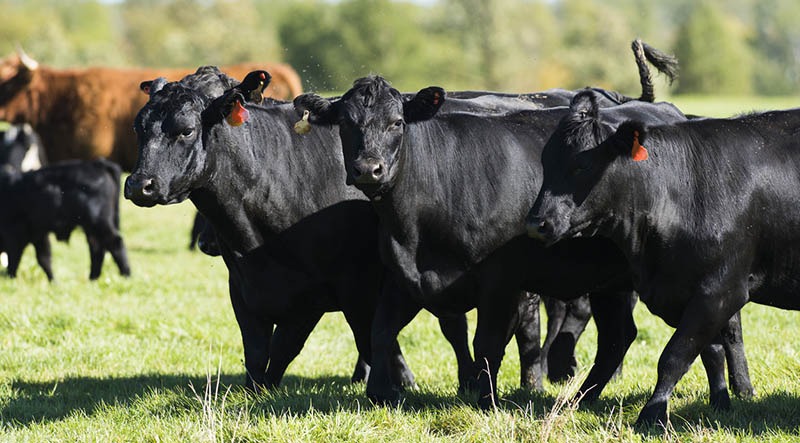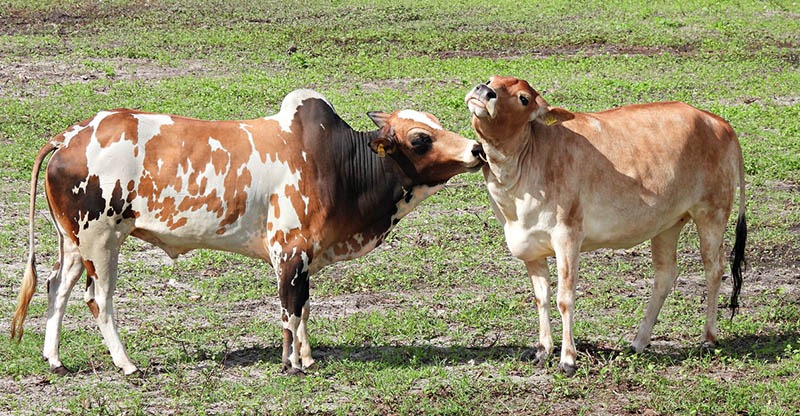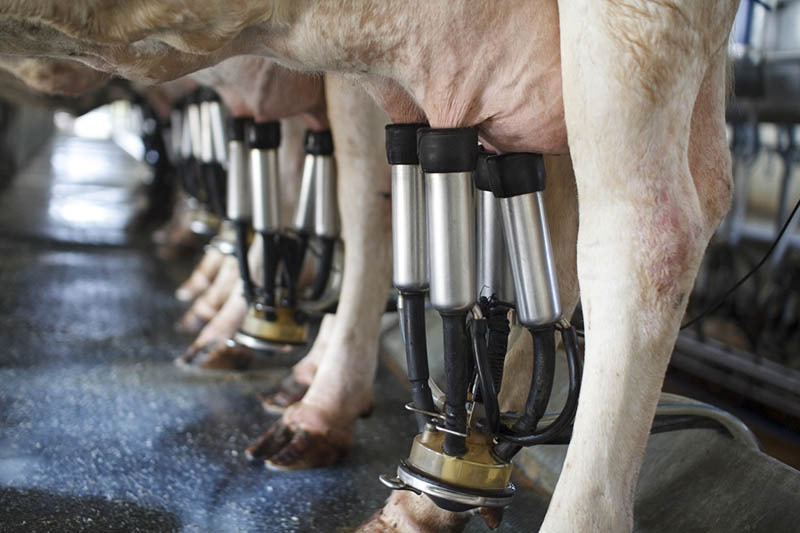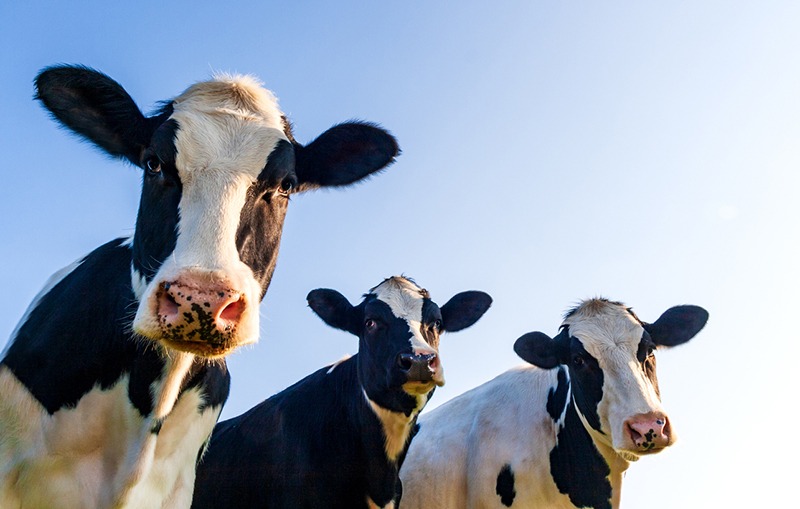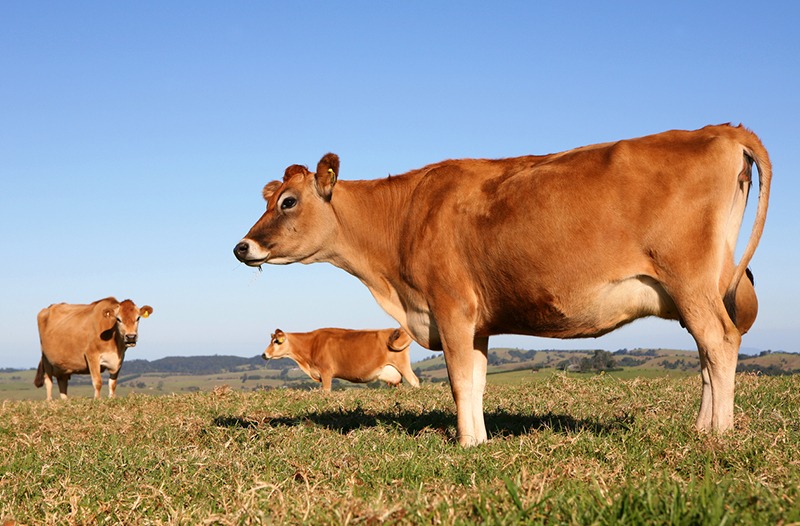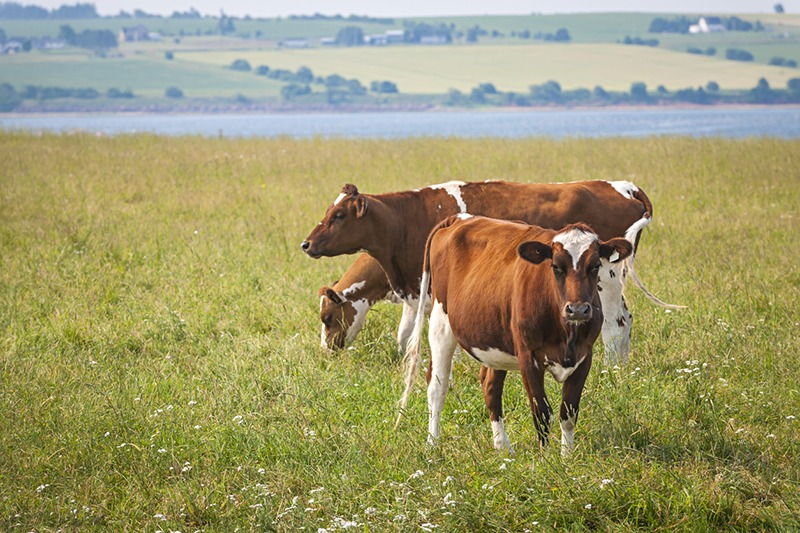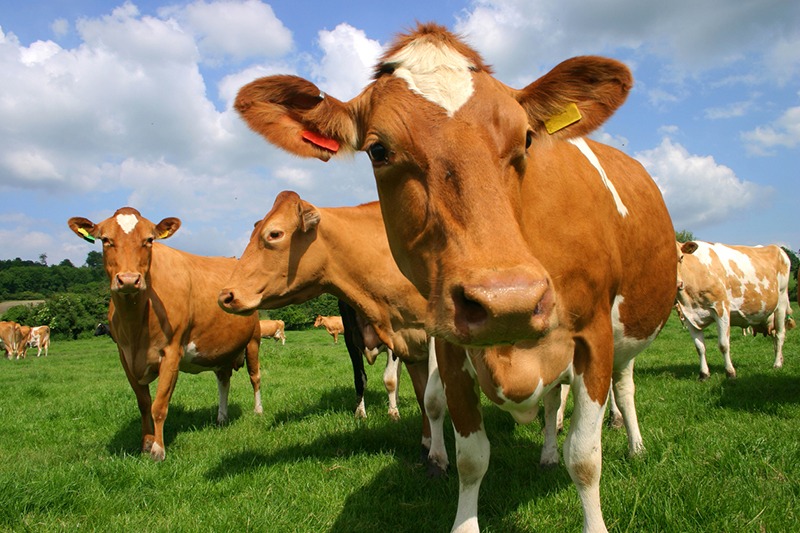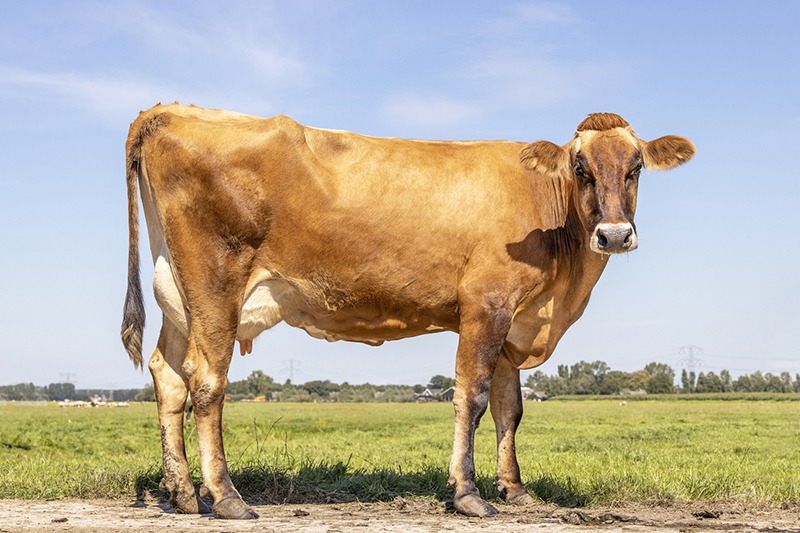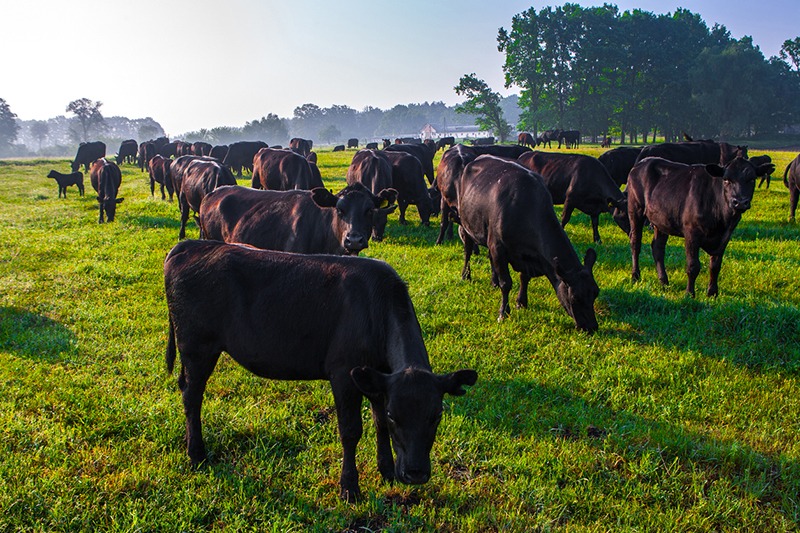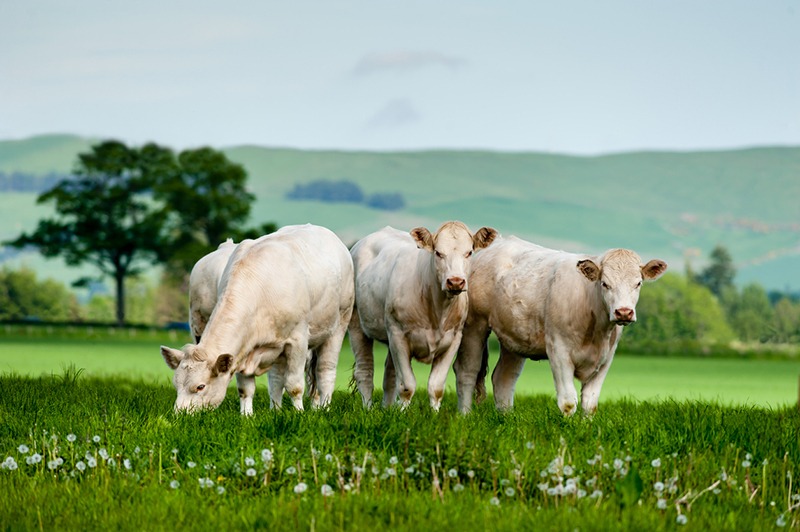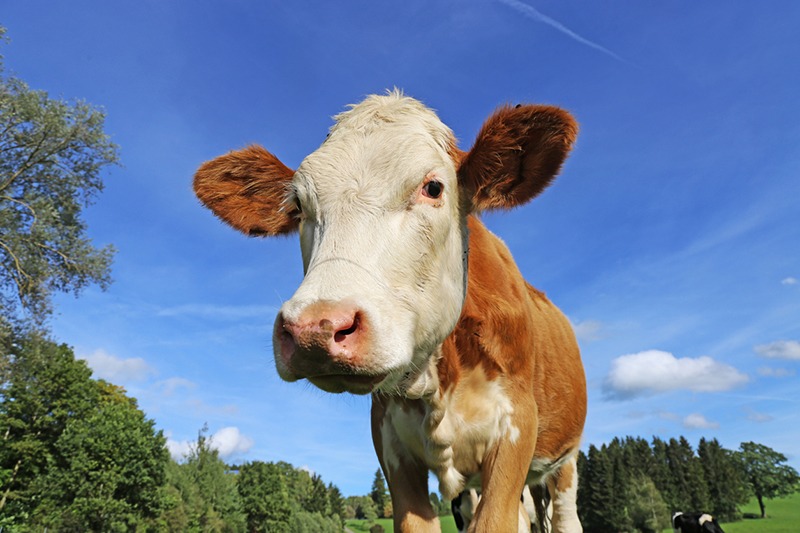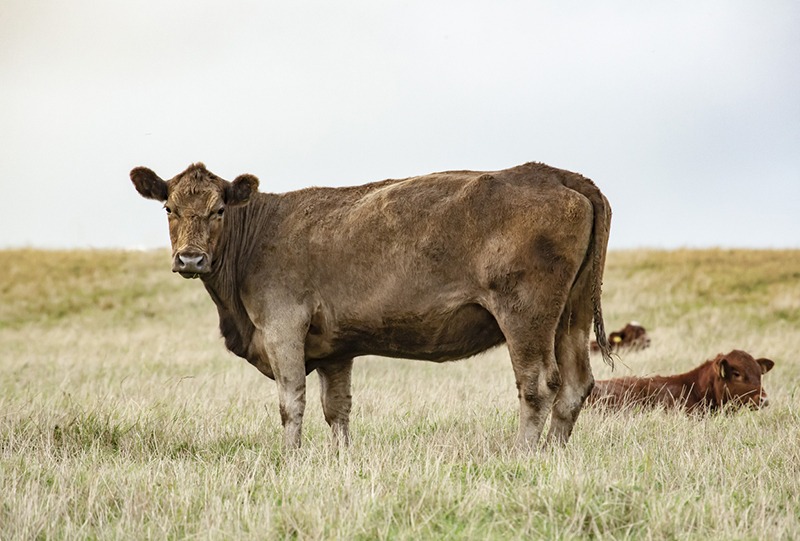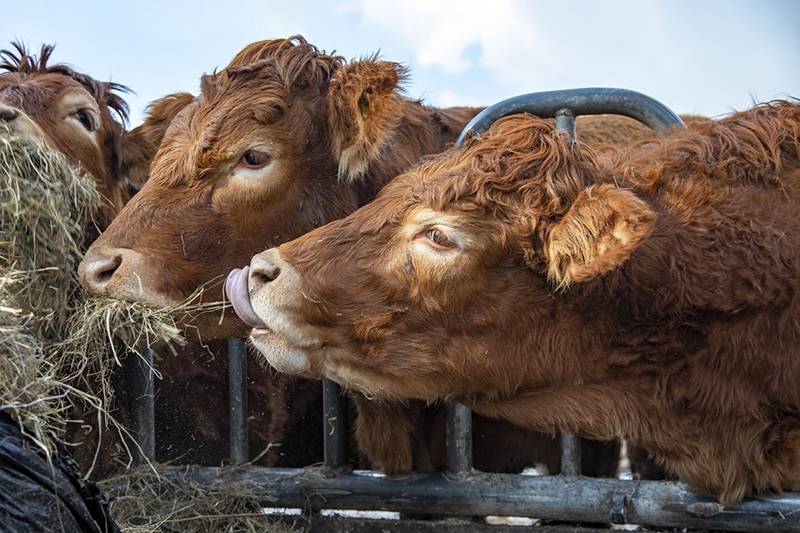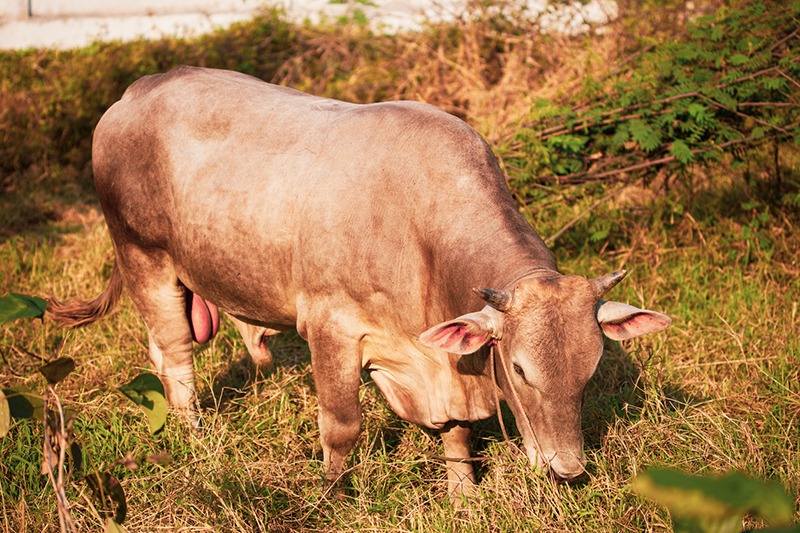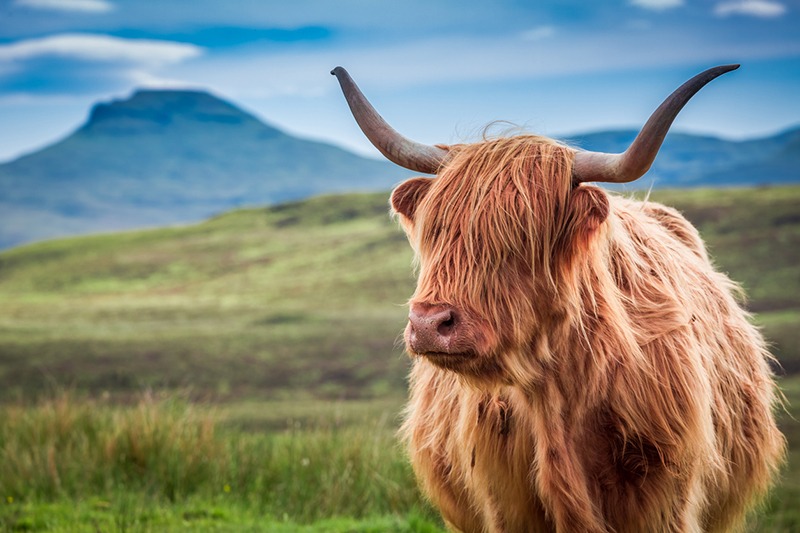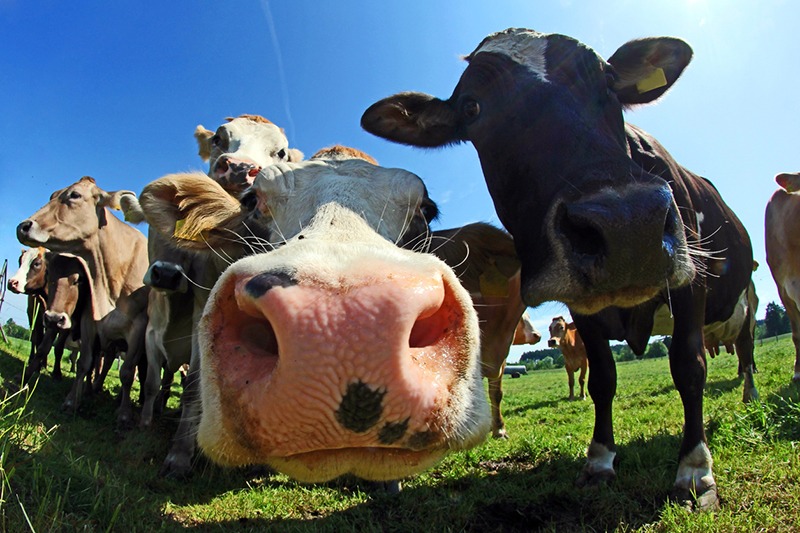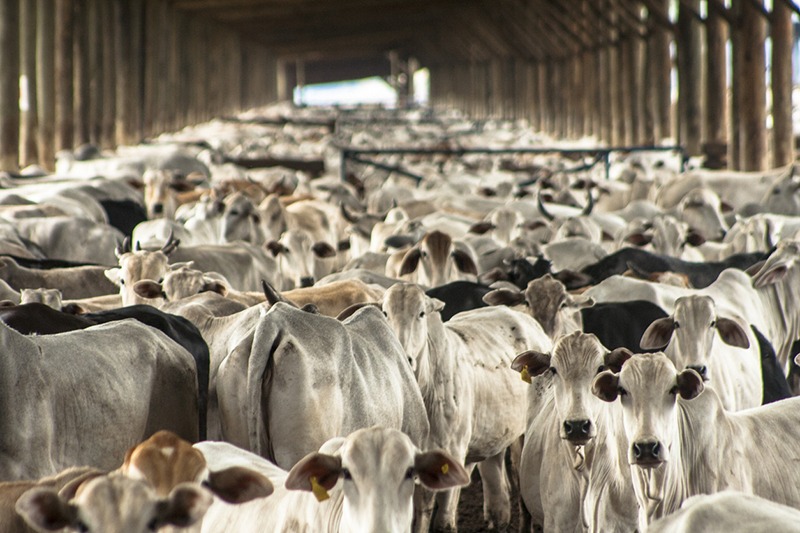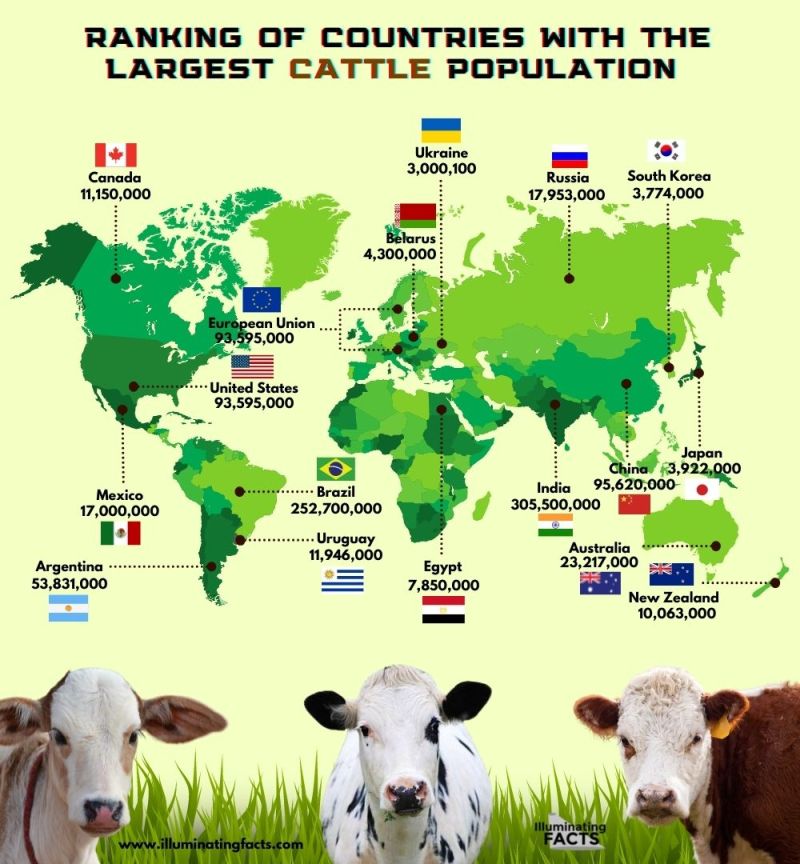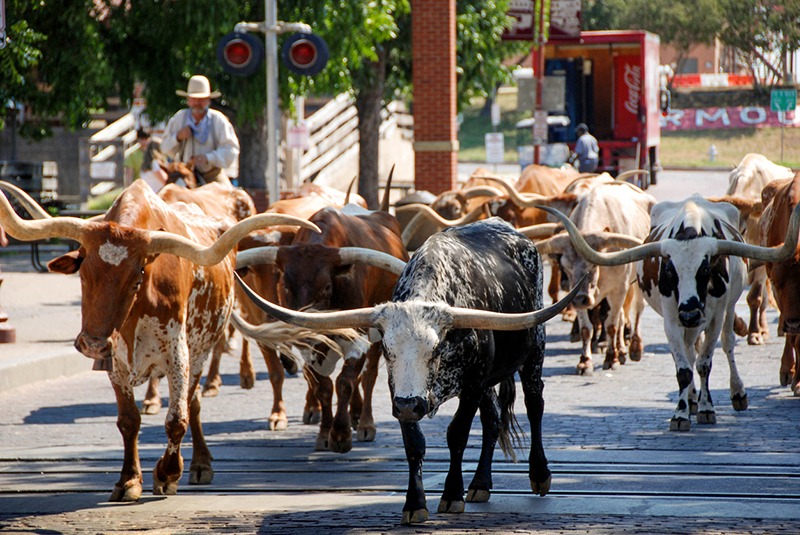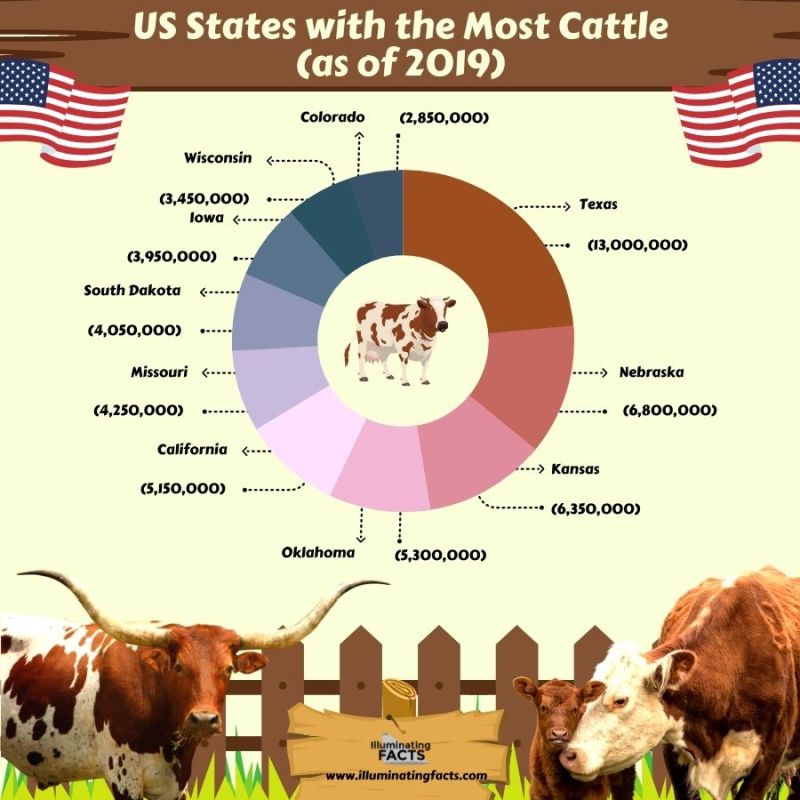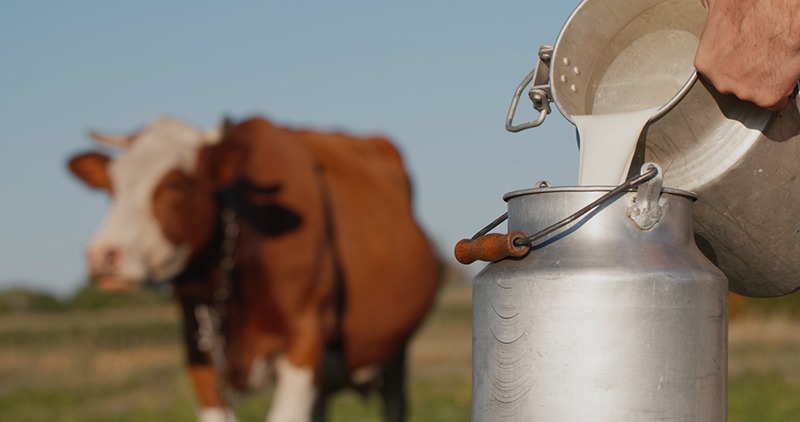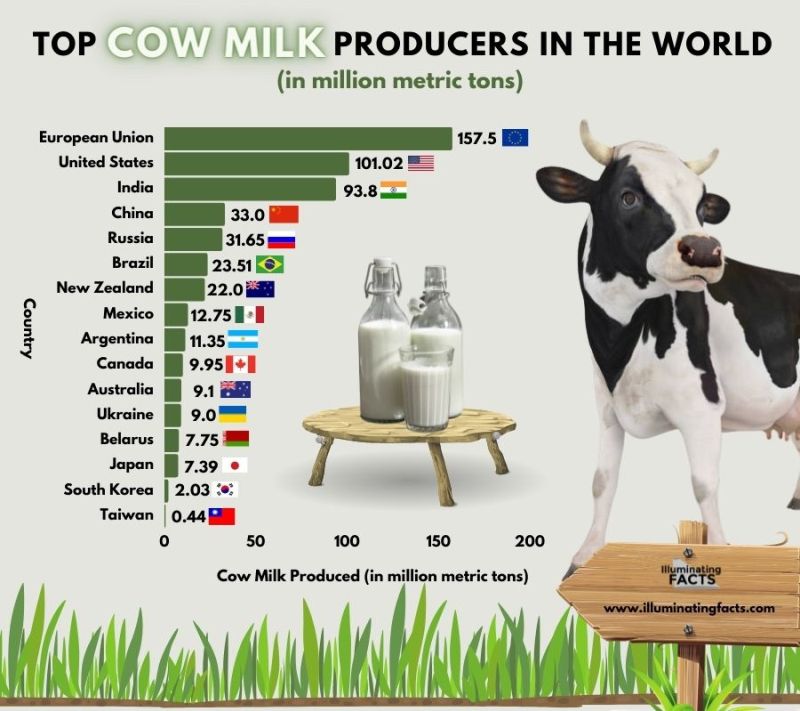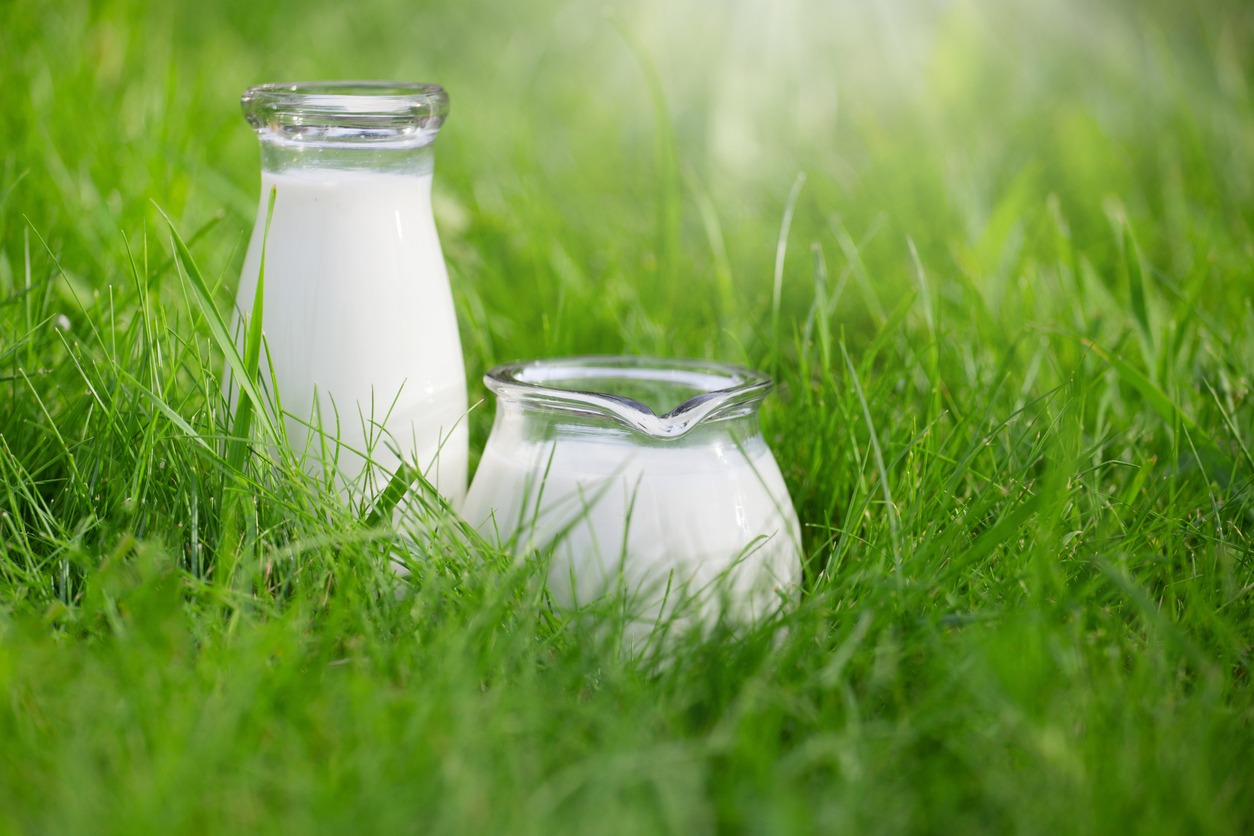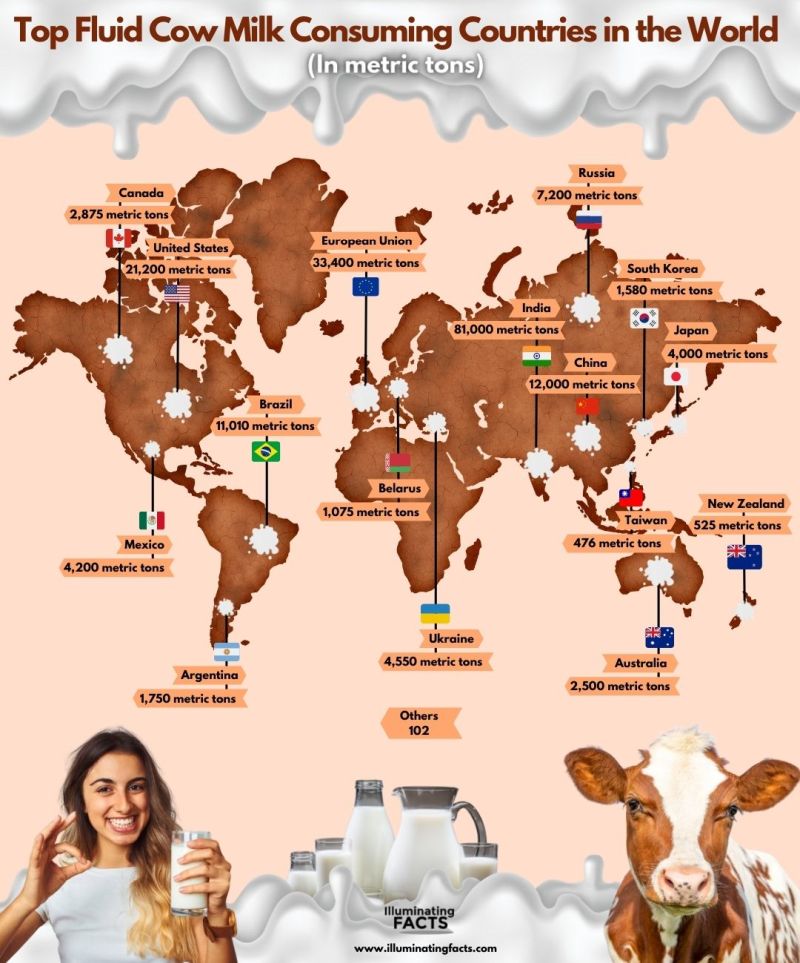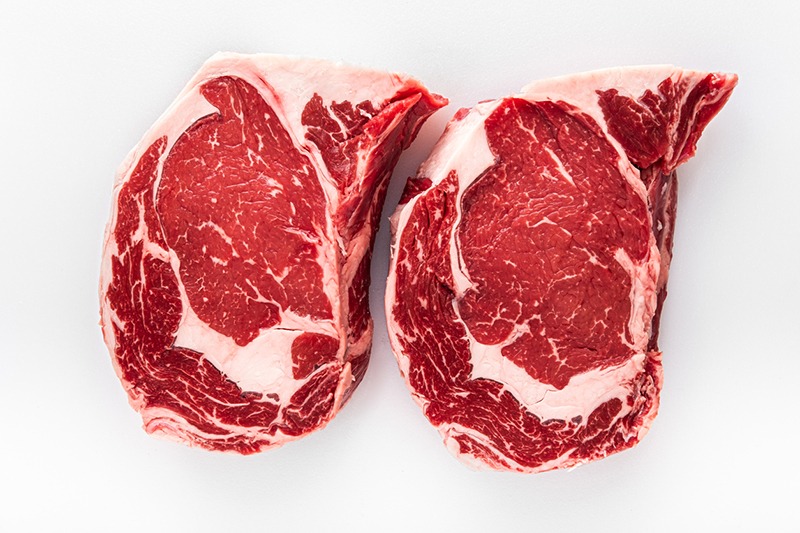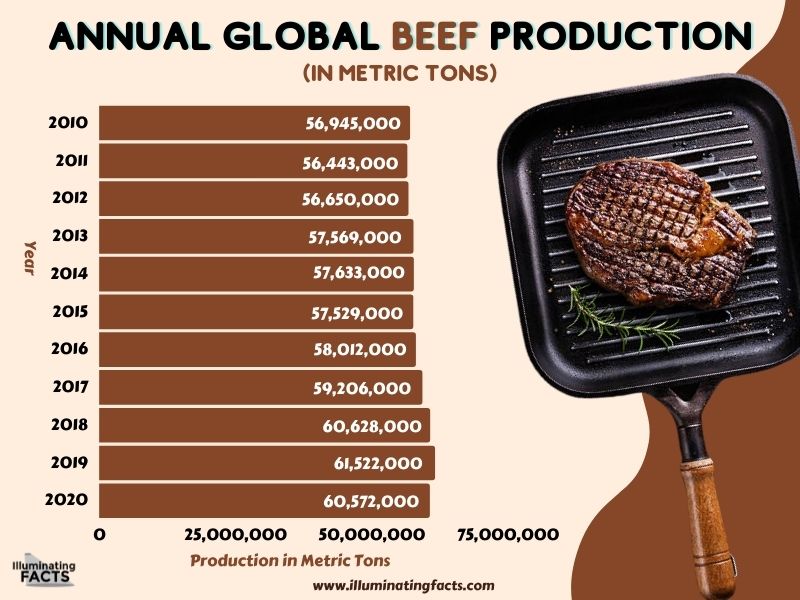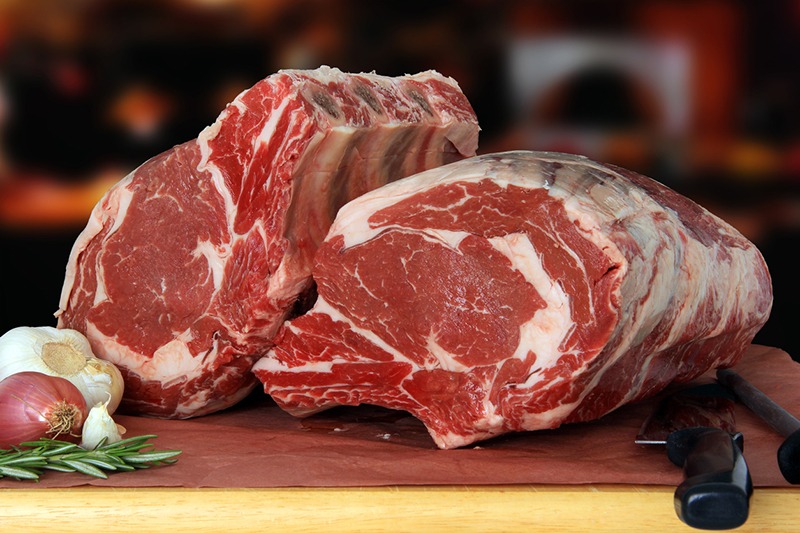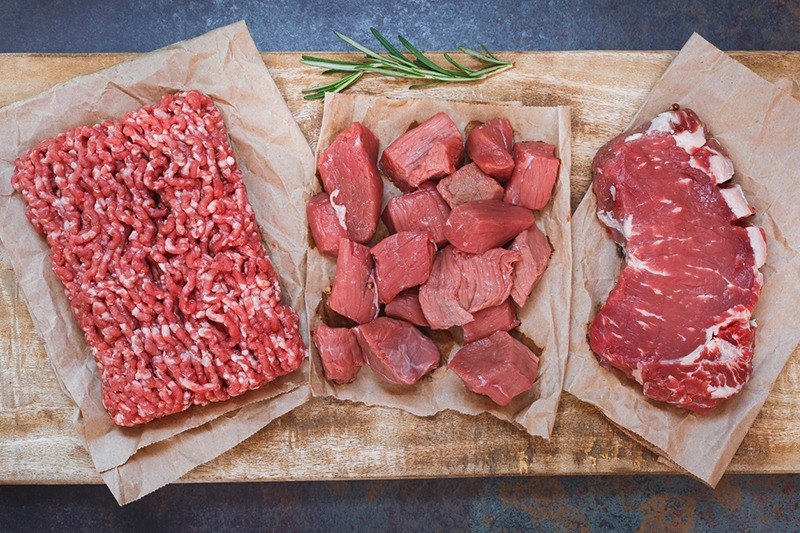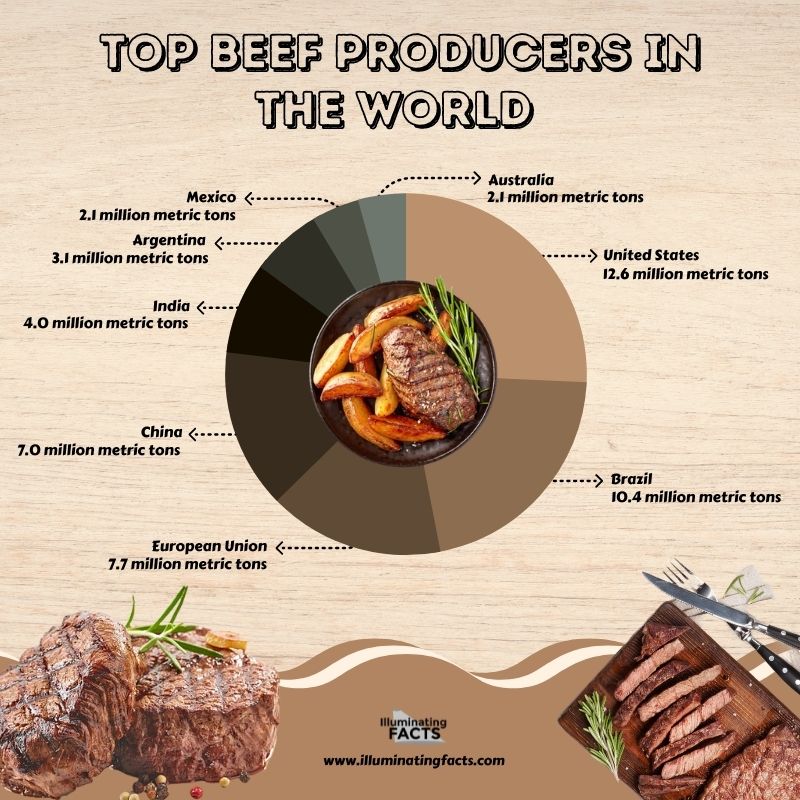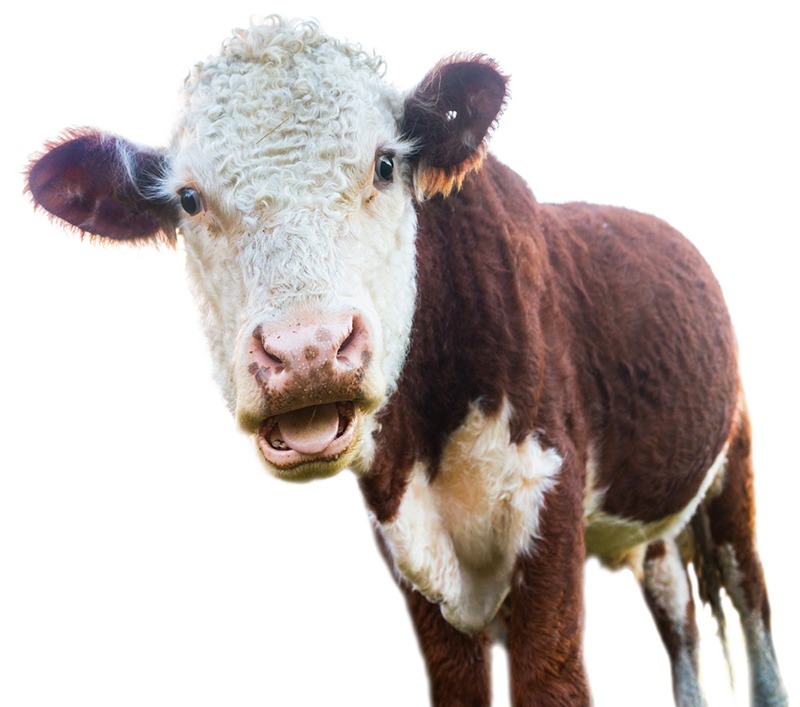Background
Cattle are among the most popular farm animals in the world. It’s not hard to tell why: cattle have contributed a lot to human survival, providing us with milk, meat, nourishment, labor, and other by-products we utilize in everyday life. On a different note, cows also play a significant role in the economy, being a vital source of income and generating employment and security for millions of people around the globe. Today, there are more than 1 billion head of cattle in the world, a number that proves how valuable cattle are.
In this article, we’ll know about cows, their interesting origin, domestication, and history with humans, as well as their general classification, breeds, population, and milk and beef production. Figures are then supported by effective visualization of numerical data for better understanding. A list of 50 interesting facts and a final takeaway are also included in this cattle call for all who want to be showered and delighted with more valuable information about the world of cows.
History of Cows
Cattle’s domestication began around 10,000 years ago during the Neolithic Period when people abandoned the nomadic, hunting-gathering way of living and started adapting to a sedentary farming lifestyle. It’s one of the major accomplishments of humanity, given the various benefits cattle have brought to humans.
Taming began at two distinct points, the Near East and South Asia, giving birth to the two main cattle breeds: the taurine and zebu cattle. From their points of origin, cattle have spread steadily across other nations. It was long enough when they reached India and were treated as holy, and arrived in the Greek and Roman Empires where they flourished.
Though the Middle Ages became a challenging time for cows, they recovered and were introduced to the New World and other continents. By the 18th century, the first breeds were developed. In the 19th century, technological progress and government-supported programs aided in the creation and spread of the most productive breeds. Today, cattle’s significance to humans is indubitable and will likely remain in the future generations.
Overall Timeline
10,500 years ago: Taurine cattle were domesticated in the Near East
Archaeological data and genetic studies show that the first domestication of wild aurochs (Bos primigenius) occurred in the Near East during the Neolithic Period, giving rise to the modern Taurine cattle (humpless cattle, B. taurus). [1]
10,000 years ago: Taurine cattle’s Westward Expansion
Agricultural societies began extending to the West, bringing their crops and livestock to new places, such as in central Anatolia (modern-day Turkey) and Europe 10,000 and 8,500 years ago, respectively. People were deemed to have taken two migration routes, through the coasts of the Mediterranean and along the Danube River.
Around 7,900 to 7,000 years ago, the concept of farming was established in Corsica, the Mediterranean’s fourth-largest island, and in Spain’s eastern coast via the first route. Meanwhile, Central Europe saw the arrival of domestic cattle around 7,500 years ago via the second route. About 1,000 years later, domestic cattle reached northern Europe. [2]
8,500 years ago: Zebu cattle were domesticated in South Asia
Two millennia later, another cattle domestication happened, but this time in South Asia, specifically in the Indus Valley. It resulted in the modern Zebu cattle (humped cattle, B. indicus). Supporting this was the Zebu fossil remains discovered in Mehrgarh, a Neolithic archeological site in Pakistan, dating 8,000 years ago. [2]
8,000 years ago: Taurine cattle reached North Africa
Domesticated cattle first reached North Africa around 8,000 years ago. Herding began in what today is Egypt and spread to other parts of the continent. Archeological evidence dating as early as 7,000 years ago was discovered in the country, as well as in Libya, and the green Sahara. Rock engravings, tracking around the same time and depicting the long-horned cattle, the possible ancestors of the West African cattle, were also found. [2]
7,500 years ago: Cows were milked
Around 7,500 years ago, European farmers in southeast and northern Europe began milking bovines, with isotope analyses of unearthed ceramic pot shards showing the presence of cattle dairy fat products traced to that date. Milking of cattle started a little later in Great Britain, around 6,000 years ago. [2]
6,000 years ago: Zebu cattle began their dispersion
Around 6,000 years ago, domesticated cattle already spread through northwestern South Asia. From there, the cattle dispersed towards South Asia and Southeast Asia, and southern China around 5,500-4,000 and 2,500 before the present (BP), respectively. [3] A Harappan seal from around 5,500-3,500 years ago signaled that the taurine and zebu cattle have already co-existed in India in the same period. [2]
5,000-4,000 years ago: Taurine cattle reached China
Taurine cattle have arrived in China at about 5,000-4,000 BP. This eastward migration has been supported by various archeological evidence found, dating 4,500 to 2,300 years ago. Yet, a Bos mandible was discovered in northeast China, aged 10,660 years, a site and era previously not thought to be the origin of cattle domestication.
A DNA sequence was performed and confirmed that the bovine jaw came from a transitional batch of wild and domesticated cattle. However, the lack of archeological evidence from 10,660 to 5,000 years ago implies that the endeavor to tame cattle at that time was inefficacious. [2][4]
4,000 years ago: Taurine and zebu cattle continued to spread
Initially, taurine cattle were restricted in the Saharan-Sahelian belt, but a climate change around 4,000 years ago turned the lush savannah of the Sahara into a desert, forcing pastoralists to leave. As such, cattle began to spread through different parts of Africa throughout the next thousands of years. [2][5][6]
Zebu cattle were believed to have been first introduced in East Africa around the same time, as supported by DNA studies. Depictions of humped cattle in Egyptian works and zebu cattle vertebrae, tracing 3,500 BP, were found in the country. Similar zebu-type fossils were also discovered in Somalia, aged 3,500-2,500 BP. [2]
1,750 years ago: India venerated cows
India’s reverence for cows can be traced 2,000 years ago, with the arrival of the Vedic Aryans after the fall of the Harappan civilization. These Indo-European valued cattle for their economic significance and used them as a symbol of wealth. They also offered them in rituals and linked them to different deities. Though cattle was not entirely deemed “sacred,” the concept of the cow’s sanctity was later adopted with the rise of major religions post-Vedic period. [7][8]
Greek and Roman Empire Era: Cattle continued to prosper
Detailed contemporary accounts for cattle husbandry were recorded during the rise of the Greek and Roman civilization, thanks to their advanced literacy. At the height of the Hellenistic era, cattle served many purposes, from beef production to milking, sacrifice, and traction. During the Roman period, cattle were also exploited for meat production and pulling loads. Though they used cows for milk production, the Romans preferred the easily-digestible sheep and goat’s milk. [2][9]
The Middle Ages: Cattle’s tough time
With the demise of the Roman Empire, cattle went through a challenging time, after European people experienced a period of unrest and massive migrations. During the early Middle Ages, Roman culture, technology, and infrastructure decayed and disintegrated. Wars, raids, the influx of people, famines, and plagues occurred throughout the entire Middle Ages resulting in the ravage of the cattle’s population.
From 1315 to 1317, the Great Famine wreaked havoc, leading to a tenth to a quarter decimation of the population in Northern Europe. Three decades later, the Black Death followed from 1349 to 1351. It was the most fatal pandemic in the planet’s history, killing nearly one-third of the human population. As such, agricultural production almost halted, and cattle farming went extensive.
Fortunately, the human population recovered swiftly during the Renaissance Period starting in the 14 century. Thus, also improving the number of livestock. Technological advancement and urbanization paved the way for the rebirth of society. Animal cultivation also benefited with the introduction of tenancy, fencing of pastoral lands, and better production and storage of feed, all leading to improved survival and productivity rates. [2]
1493: Christopher Columbus brings cattle to the New World
On his second voyage in 1493, Christopher Columbus brought domesticated animals to the New World, including dogs, chickens, pigs, sheep, goats, horses, and cattle. In the next 50 years, the Spanish colonists brought more cattle, which rapidly spread across southern North America and northern South America.
In 1521, cattle arrived in Mexico. Three years later, they reached present-day Colombia while following cattle imports infiltrated Central and South American coasts. In 1525, the cattle population already reached a thousand in the Caribbean, further spreading to other Spanish colonies in America. By 1540, about 500 Spanish cattle traversed the Rio Grande and became the precursor of the famed Texas longhorns. [2]
1627: Aurochs became extinct
The Aurochs, the wild progenitor of all modern cattle, became extinct in 1627 after a poacher killed the last surviving individual in Warsaw, Poland. While other aurochs may have lived in other areas in the world, there is no proof to back up the theory. [10]
18th century: The Birth of the First Cattle Breeds
With the start of the Industrial Revolution, urbanization sped up, heightening the need for agricultural products in the cities. The British Agricultural Revolution also followed suit, which led to one of the most significant innovations in the history of cultivating livestock – the development of the first cattle breeds, their fast acceptance, and their registration in the herd books. Through genetic isolation and selective and systematic breeding, the 18th century saw hundreds of breeds introduced. [2][11]
19th century: Breeds reached other countries and continents
Importation of the newly-developed breeds reached not only the New World but also other countries and continents. Breed development was temporarily halted during WW1, with some of the breeds even perishing into oblivion. With that, production became the primary focus after the global conflict. Technical progress and government-backed programs encouraged the rise of the most productive breeds, animal healthcare, regulated cultivation, and the establishment of national herdbooks. Thus, it also resulted in the rise of many breeds from many nations and regions, varying in performance and appearance. [2][11]
Today: Cows continue to be an integral part of human lives
Since the Neolithic period, cows have provided us numerous benefits and contributed to our survival for thousands of years, proving that their domestication is one of humanity’s most significant achievements. From the beginning and for generations to come, cattle will remain an integral part of human lives, providing food, milk, labor force, and other by-products.
A Summary
The overall timeline of the History of Cows is illustrated in the image below.
Two Basic Classifications of Cattle
Cattle can be generally divided into two basic classifications: the taurine or European (Bos taurus) cattle and the indicine or zebu (Bos indicus) cattle. Though they are considered two distinct species, both came from the same wild ancestors, the aurochs. While there are also significant physiological and physical differences that can be seen between the two, these cattle can be readily interbred. [12]
Taurine cattle
Taurine cattle are breeds that are of European origin and are typical in the continent, as well as in north-eastern Asia and Africa. Also called the non-humpless cattle, they reached the United States and Australia via the European explorers. Some of the famous varieties include the Hereford, Charolais, and Angus breeds.
Indicine cattle
Indicine or zebu cattle are breeds that originated from South Asia. The conspicuous external trait that separates them from taurine cattle is their distinctive humped back. They also have larger, dropping ears, a dewlap, and a shorter coat. These cattle have lower nutritional requirements due to their smaller size, partial resistance to tick-borne diseases, and higher heat tolerance, making them more adapted to tropical environments. Breeds that fall under this group include the Brahman, Red Sindhi, and the Sahiwal cattle. [13][14]
Most Popular Dairy Cattle Breeds
The dairy cattle industry is continually emerging, actively contributing to small to large economies, from communities to regions and countries. With the industry’s further expansion and the intensifying global trade, getting good quality cattle breeds is a must to meet the demand and support the world’s food system. Truth be told, there are many breeds exclusively bred for milk production, but here are the most popular cattle breeds used for the said purpose. [15][16][17][18]
Holstein
Holsteins are the typical black-and-white cows most people think of picturing as dairy cows. They trace their roots from Holland, specifically from the provinces of West Friesland and North Holland, and were brought to America in the 1850s. Today, they consist of nearly 90% of the dairy cows in the U.S. and are distributed in other nations as well, making them the most common among the dairy cattle breeds. No wonder, as Holsteins yield 2,674 gallons or 23,000 pounds of milk per lactation [19], also placing them as the best milk producers in the cattle world.
Jersey
Jersey dairy cows originated from the Isle of Jersey in the English Channel. While their exact origins are unknown, they are deemed to have been developed from the black cattle’s introduction to France and Britain before 1,100 AD.
They are the smallest among the dairy cattle breeds, with an average cow weighing only 1,500 pounds. They have soft, brown, or fawn hair, large bright, beautiful eyes, and a broad forehead. Very hardy and adaptive, Jersey cows can adjust to various environments and climates, specifically to higher temperatures. Plus, they have a lower maintenance intake, given their smaller size.
Though the average return of Jersey is only 1,860 gallons or 16,000 pounds, [19] what makes them popular is the high percentage of butter fats in their milk at 5.3%. [20] As such, they yield the richest milk compared to other cattle breeds and are often used for making butter and cheese.
Ayrshire
Due to their size and vigor, the Ayshire are often dubbed the “aristocrats” of the dairy cattle breed. They also boast a strong character, seemingly displaying their heritage. Ayrshire cows were particularly developed in the county of the same name in Scotland and arrived in the United States in the 1800s.
The Ayrshire breed comes in orangey-brown, mahogany, and cherry red combination with white. They have sturdy legs and feet and have great grazing abilities. Incredibly strong and robust, Ayrshire cows are very adaptable to their environment, allowing them to be present in many parts of the world, even in Southern Africa.
With 4% fat compared to the 3.6% average of the Holstein, Ayrshire dairy cows’ milk quality is better than the former. However, Holsteins have a higher potential yield, giving them an edge over the latter. Nevertheless, Ayrshire still ranks as one of the world’s best dairy cattle breeds.
Guernsey
The Guernsey breed originated from the Isle of Guernsey in the English Channel, situated between France and England. They are believed to have been developed from the cattle brought from Brittany and Normandy in France. Their color ranges from fawn to golden, often with clearly defined white markings.
Renowned as the “Royal Breed,” the Guernsey dairy cows yield rich, golden-colored milk with 4.5% butterfat content. The color is attributed to the high percentage of beta carotene (vitamin A source) in their milk. Their average yield is 1,700 gallons or 14,700 pounds per lactation.
Brown Swiss
The Brown Swiss is native to the Alps of Switzerland. They are believed to be the oldest among the dairy cattle breeds, with bones similar to the modern individuals unearthed in the Swiss lake dwellers’ ruins, dating back to 4000 BC. [21] Today, the breed is scattered and widely distributed in many countries, such as in the United States, South America, Mexico, Hungary, Italy, and Austria.
Also called the Braunvieh, the Brown Swiss generally has a light to dark brown color, with a white muzzle, big furry ears, black nose, and black tongue. They are known to be docile and easily manageable, perhaps brought by their centuries of domestication and development. Milk production per lactation is 2,450 gallons or 21,000 pounds, making them the second most productive dairy cattle breed. Though they are dual utility, which means they can also be used for beef purposes, the Brown Swiss cows are more favored for their milk production.
Milking Shorthorns
The Milking Shorthorns is another dual-purpose breed used for meat and milk production but mainly utilized for the latter. They are very hardy, versatile, and well-adapted even to harsh conditions. Adding their calm disposition, efficient grazing ability, and easier manageability, these reasons may explain why the Milking Shorthorns were one of the first breeds to be introduced to other parts of the world from Britain. They produce 1,800 gallons or 15,400 pounds per milk cycle and are known for their milk’s high protein-to-fat ratio.
Most Popular Beef Cattle Breeds
The beef cattle industry is as popular as the dairy cattle industry, providing consumers with high-quality, nourishing beef, which is an important source of nutrition and a part of a healthy diet for millions of people across the world. Global demand for meat, in general, has been rising over the past decades, which is why production has also tripled to match supply. [22] Like with the dairy industry, there are also cattle breeds popularly raised and used exclusively for commercial beef production and yield the best products. Learn more about them below. [23][24][25][26]
Angus
The Angus came from northeastern Scotland and was brought to the U.S. in 1873 and gained footing in Kansas. Today, it is the most common beef cattle breed in the United States and the gold standard of beef in many parts of the world. Their meat is a premium, well-marbled, flavorful, and tender, making them a genuine star beef producer. Angus cattle are hardy in cooler climates but may overheat in hotter ones. Nevertheless, their low risk for dystocia, or reproduction issues, and their relatively heavier body weights, apart from their high-quality breed, made them quickly well-loved in the beef cattle industry.
Hereford
Hailing from Herefordshire, England, the Hereford cattle was developed during the 1700s to meet the increasing demand of the food market in line with the surge of the Industrial Revolution. Thus, producing a breed that’s efficient for production and provides a high yield of beef. are large, muscular, trim, and smooth, and are well-developed on parts where preferable cuts are obtained, such as in the loin, back, and round or the hindquarters.
Hereford cattle are known for their docility, hardiness, longevity, and high adaptability to various climatic conditions. Plus, they also mature early and have a good fattening ability. Today, they are pretty common, with millions of them scattered worldwide.
Charolais
Charolais cattle were developed in France where it became a multi-purpose breed, used for milk, meat, and drafting. The light-colored cattle have a larger and stronger frame, which made them suitable for pulling wagons and working in fields. When the breed came to the United States in the 1930s through Mexico, it had a significant effect on the industry, as it came at a time when people were looking for a bigger breed than the traditional British ones. Today, they are valued as beef producers, thanks to their heavy weaning weights, incredible muscling, and feed efficiency. Bulls are also often added in herds to increase the ruggedness and size of the calves.
Simmental
The Simmentals came from Switzerland, and are among the oldest and most widely distributed cattle breeds worldwide. They are usually red-and-white, though there’s no restriction on the color of the breed. Simmentals are generally popular for their rapid growth development and larger frame. In Europe, this cattle breed is more utilized for milk production, but Simmentals in America are specifically bred for producing heavier, leaner, and higher yields of beef.
Gelbvieh
The Gelbvieh breed originated in Germany and was developed as a multi-purpose cattle, milk, meat, and work. In 1971, they were introduced to the U.S. via artificial insemination. Today, the red/tan breed is adored for its high fertility, great mothering ability, and calving ease. Not to mention that they are also quick-growing and mature faster compared to their other European counterparts.
Limousin
The Limousin breed is an old breed that originated from France, specifically in the regions of Marche and Limousin, hence its name. From Canada, they were imported to the United States in 1971 and have spread across North America. The golden-red breed is well-muscled, but are finer-boned than Charolais cattle, making them less prone to calving problems. They also grow rapidly and boast excellent carcass traits, quickly gaining attention in the beef cattle industry.
Beefmaster
The Beefmaster is a beef cattle breed that originated in the United States. They were developed by crossing the Brahmans with the Hereford and Shorthorn. The resulting breed is heat-tolerant cattle, with excellent beef production. Though they mainly have a red coat, Beefmaster cattle may appear in any color or be spotted. They are superior beef cattle, with good temperaments, high fertility, and growth. They are also resistant to many parasites and diseases but don’t require pampering, making them popular in the beef cattle industry.
Scottish Highland
The Scottish Highland cattle is one of the sturdiest breeds, having survived the harsh, chilly highlands with sparse forage. They thrive on weeds and brush, which other cattle breeds pass by, and in poor conditions where others will immediately perish. Living for centuries in such an environment, the breed has also developed resistance to many bovine and stress-related diseases. Scottish Highland cows also have conspicuous long horns plus long hair, often appearing in red but can also be tan to black. They have less fat, as their double coat already acts as their shield against the cold weather and snow. Thus, producing high-quality, lean, flavorful, and well-marbled beef.
Cattle By-Products: Other Surprising Uses of Cattle Besides Meat and Milk
It can be surprising but only 60% of cattle are utilized for food. So, what happens to the remaining 40%? Well, they are used in manufacturing by-products, ranging from industrial to household, pharmaceutical, and health products, that people use nearly every day. Look at the cow’s parts and the products where they end up. [27][28][29]
Cows By the Numbers
This section will cover all significant data and numbers about cattle population worldwide, in countries, and in the U.S. States, as well as important figures in cattle’s primary uses: milk and beef production. Information is then presented in charts and graphical illustrations for a quick view and grasp of all the statistics.
Global Cattle Population
From 2012 to 2014, the global cattle population was at the one billion mark and increased steadily to 1.00172 billion, 1.0053 billion, and 1.00857 billion head, respectively. In 2015, it plunged to 969.26 million but saw a considerable increase to 978.77 million heads in 2016, 984.53 million heads in 2017, and 996.36 million heads in 2018. The number plunged by 7.33 million in 2019, going down to 989.03 million heads, and saw another 1.28 decrease in 2020 to 987.75 million heads. The cattle population recovered and hit the billion mark again in 2021 at 1,000.97 billion heads, a 13.22 million increase from the previous year. [30][31]
Ranking of Countries with the Largest Cattle Population
India has the largest cattle population in the world as of 2021, with 305.5 million heads, accounting for 30.52% of the global inventory. Brazil ranked second place with 252.7 million heads (25.25%). China, the United States, and the European Union followed with a distant 95.6 million (9.55%), 93.59 million (9.35%), and 85.54 million (8.55%), respectively.
On the other hand of the spectrum were the countries: Egypt with 7.85 million (0.78%), Belarus with 4.3 million (0.43%), Japan with 3.99 million (0.39%), South Korea with 3.77 million (0.38%), Ukraine with 3.0 million (0.30%). [31][32]
The U.S. States with the Most Cattle
Texas has the largest number of cattle among the U.S. States with 13 million heads as of 2019, according to the National Cattlemen’s Beef Association. Texas’ cattle population has never gone below 11 million since 1967. The Lone Star State is also the biggest producer of beef in the country, with 4.7 million of its inventory used for meat.
Nebraska came second with 6.8 million cattle, outnumbering the 1.8 million people living in the state. Kansas followed with 6.35 million, Oklahoma with 5.3 million, and California with 5.15 million heads. Completing the top 10 were Missouri, South Dakota, Iowa, Wisconsin, and Colorado. [33]
Top Cow Milk Producers in the World
The United States led the world in terms of cow milk production in 2020 with 101.02 metric tons, as per Statista. India ranked second with 93.8 metric tons produced. The European Union toppled both nations’ production with 157.5 million metric tons, but it’s been collectively produced by its 28 member countries. Other top cow milk-producing countries include China, Russia, and Brazil, with 33 million, 31.65 million, and 23.51 million metric tons produced, respectively. [34]
Top Fluid Cow Milk Consumers in the World
As per Statista, India was the top consumer of fluid cow milk in 2020, drinking more than 81 million metric tons. While the United States topped the cow milk production, it only consumed 21.2 million metric tons (20.94%) of fluid cow milk it produced for the year. The same goes for the EU, which only drank a total of 33.4 million metric tons (21.2%) of their total cow milk production. Other leading fluid cow milk consumers were China with 12 million metric tons, Brazil with 11.01 million metric tons, and Russia with 7.2 million metric tons consumption. [35]
Annual Global Beef Production
In 2020, the world produced 60.57 million metric tons of beef, based on USDA data. Though it decreased 950,000 metric tons from 2019, it was the third consecutive year when global production went over the 60 million mark, producing 60.62 million metric tons of beef in 2018 and 61.52 million metric tons in 2019. Since 2010, worldwide beef production only plunged two other times: 502,000 metric tons in 2011 and 104,000 metric tons in 2015. Comparing 2020 to 1960, beef production in the world has more than doubled 1960’s output at only 23,599,000 million metric tons. [36][37]
Top Beef Producers in the World
As per the USDA and FAO, the United States was the leading beef and veal producing country with 12.6 million metric tons produced as of Q1 2021. Second on the list was Brazil with 10.4 million metric tons, followed by the European Union with 7.7 metric tons, and China with 7.0 million metric tons. India ranked fifth with 4.0 million metric tons, yet it includes beef derived from water buffaloes. Completing the top 8 beef producers were Argentina, Mexico, and Australia, with 3.1 and both 2.1 million metric tons of beef produced in 2020. [38]
Top Beef Exporters in the World
While the U.S. was the biggest beef producer in 2020, it only ranked second in terms of beef exports. Brazil, which then ranked second in production, led the world in exports with 2.7 million metric tons of beef shipped to countries. The United States, Australia, and India all exported 1.4 million metric tons. Argentina also joined the list of leading exporters with 800,000 metric tons, followed by Canada, New Zealand, and Uruguay, with 600,000, 500,000, and 400,000 metric tons. [39]
Top 50 Interesting Facts About Cows
- A cow’s natural life expectancy is about 20 years, with some even reaching 25 years old. Age can be determined by looking at its teeth or the number of rings on its horns. However, cows don’t normally go beyond the age of five in the dairy industry.
- Cows are ruminant animals, which means they have four stomachs that allow them to consume feeds like hay and grass that humans couldn’t eat.
- Aside from “mooing,” cows use facial expressions, body language, and positioning of their head, limbs, and tail to communicate.
- Cows constantly move when grazing and can cover about 13 kilometers (8.07 miles) per day.
- Cattle are naturally fearful since they have evolved as prey animals. They can be scared or reactive towards unknown or strange scents, noises, objects, and situations. The level of fear heightens when they’re alone or isolated.
- Just like with human beings, cows’ pregnancy lasts nine months. Calf at birth weighs 45 pounds on average and can already stand and walk in an hour or two.
- Cows usually give birth to one calf per pregnancy. However, there is a 5% chance that they can give birth to twins. However, such instances pose lots of risks for both the mother cow and her calves.
- Cows possess an acute sense of smell, helping them detect odors up nearly ten kilometers or six miles away, which is then beneficial for them in recognizing imminent danger.
- Cows’ hearing ability is better in deep and high frequencies when compared to humans’.
- As highly sociable animals, cows don’t like being alone. They thrive in small herds composed of 20-30 individuals and build close relationships with each other. Licking each other is one of their ways to establish ties, which also has a calming effect on them.
- Cows drink 100 liters of water daily.
- Cows have nearly an all-around view at 330°. They are colorblind to red and can only see the colors: yellow, green, blue, and violet.
- Cattle don’t require much sleep, only needing around 30 minutes of deep sleep daily, scattered in 6-10 periods. However, they are lying down for up to 10 to 12 hours daily.
- The cow’s tongue is a national cuisine or delicacy in some countries. For instance, the United States serves them in open-faced sandwiches, while Mexico uses them as taco fillings. Belgium, France, Germany, and Poland also use them in their dishes.
- All 50 U.S. States raise beef and dairy cattle.
- Killing or injuring a cow can get you jailed in India. Hindu nations revere cows and do not eat beef as they treat the animal as holy.
- Certain parts of India allow cow slaughter and where one can eat beef. Some of the Indian states that have no restrictions include Kerala, Mizoram, Nagaland, Tripura, Arunachal Pradesh, and West Bengal.
- Cows move their jaws about 40 times a minute when chewing grass or cud, totaling about 40,000 times a day.
- A cow has 32 teeth but has no upper front teeth. They chew by pressing their bottom teeth against the hard-top palette of their mouth.
- A “cow” refers to an older female that has given birth. A “Bull” or “steer” refers to a male, while the baby is called a “calf.” A young female that hasn’t given birth yet is called a “heifer.”
- Cows don’t eat meat. It’s illegal to feed them any kind of meat, so all cows are actually vegetarian-fed.
- Cows stand up and lay down an average of fourteen times a day.
- Farmers utilize ear tags on cattle for identification. The system allows them to keep track of valuable information, such as gender, weight, birth date, age, etc.
- A cow’s average temperature is 102 degrees Fahrenheit.
- Cows face either north or south when grazing. Wild deers have the same behavior.
- Bovine is the scientific name for dairy and beef cattle.
- Cows use their tail for swatting flies.
- Cows’ ears are large as they help transfer heat. Cattle breeds that originated or developed in hotter climates even have larger ears, plus loose skin, to aid their bodies in getting rid of heat.
- A cow’s tongue has a texture similar to sandpaper, helping them pull the grass or hay they eat.
- Like other domesticated animals, cows enjoy being petted! They love to be stroked, scratched behind the ears, caressed, and interact with humans.
- The breeding season usually lasts three to four months. Bulls and females are kept together during the said duration. Once it ends, bulls are transferred to a different pasture and rejoin the females the next breeding season.
- Cows could climb a set of stairs, but not down, as their knees can’t bend in that direction.
- A dairy cow can produce about 125 pounds of saliva per day.
- “Blossom,” a Holstein cattle, was the tallest cow to have ever lived at 6 ft. 2.8 in.
- “Big Bertha” was the oldest living cow, having lived 48 years and 9 months from 1945 to 1933.
- Mad Cow Disease, also known as Bovine Spongiform Encephalopathy (BSE), is a lethal, progressive disease that damages cattle’s brain and spinal cord.
- A cow giving birth to quadruplets may occur once in every 11 to 15 million births.
- During the 1850s, almost every family in the United States had its own cow.
- As cattle graze, their hooves aerate the soil, enabling more oxygen to enter, which then aids in plants and grasses’ better growth.
- In colder countries, cows’ thick skin and hair serve as a natural insulator during winter, protecting them from the harsh, bitter cold.
- About a third of the farms and ranches in the United States include cattle.
- Theodore Roosevelt once owned 5,000 cattle in the Badlands of the Dakota Territory.
- The United States has over 800,000 ranchers and cattle producers.
- Corriente is the fastest steer and is primarily used in rodeos.
- Cattle kill an average of 22 humans in the U.S. annually.
- Cattle came from the Anglo-French word “chatel,” which means personal property.
- Cows are the primary agricultural source of greenhouse gases.
- Surrogacy is becoming common in cows. Hormones are injected into superior cows so they can produce multiple eggs. Embryos are then transferred from superior cows to adequate cows.
- Happy cows produce more milk. When they are stressed, their body produces cortisol, which curtails milk production.
- While it may not seem like it, cows are good swimmers. They can cross rivers, which helped people bring cows to different pastures and locations for generations. Cows will even wade into lakes and ponds to cool down and avoid insects.
Final Words
For thousands of years, cows have played a significant role in humanity. If they hadn’t been domesticated or inhabited Earth, things would have changed a hundredfold to what it is today, as we’d lose a vital source of food and income. However, it’s also good to note that cattle may not have flourished without human care. Plus, all the modern breeds also owe their existence to our intervention. It’s a mutual relationship, where each contributes to the welfare of the other. We give cattle the essential things they need while we get food, prosperity, and a better standard of living in return.
References
[1] Morphological and genetic evidence for early Holocene cattle management in northeastern China. Nature Communications. (n.d.). Retrieved October 29, 2021, from https://www.nature.com/articles/ncomms3755.
[2] Felius, M., Beerling, M.-L., Buchanan, D. S., Theunissen, B., Koolmees, P. A., & Lenstra, J. A. (2014, November 12). On the history of Cattle Genetic Resources. MDPI. Retrieved October 29, 2021, from https://www.mdpi.com/1424-2818/6/4/705/htm.
[3] Pérez-Pardal, L., Sánchez-Gracia, A., Álvarez, I., Traoré, A., Ferraz, J. B. S., Fernández, I., Costa, V., Chen, S., Tapio, M., Cantet, R. J. C., Patel, A., Meadow, R. H., Marshall, F. B., Beja-Pereira, A., & Goyache, F. (2018, December 21). Legacies of domestication, trade and herder mobility shape extant male zebu cattle diversity in South Asia and Africa. Nature News. Retrieved October 29, 2021, from https://www.nature.com/articles/s41598-018-36444-7.
[4] Neolithic Chinese People First Tamed Cattle Over 10,000 Years Ago. Sci-News.com. (2013, November 3). Retrieved October 29, 2021, from http://www.sci-news.com/archaeology/science-neolithic-cattle-01532.html.
[5] BBC. (n.d.). A History of the World – Egyptian Clay Model of Cattle. BBC. Retrieved October 29, 2021, from https://www.bbc.co.uk/ahistoryoftheworld/objects/ba9VK4iRQUybd1KMGnRimQ.
[6] Hanotte, O. (n.d.). An evolutionary jolt helped cattle to spread across Africa. now genetics must make them more productive. The Conversation. Retrieved October 29, 2021, from https://theconversation.com/an-evolutionary-jolt-helped-cattle-to-spread-across-africa-now-genetics-must-make-them-more-productive-147381.
[7] Lodrick, D. (n.d.). Symbol and Sustenance: Cattle in South Asian Culture. JSTOR. Retrieved October 29, 2021, from https://www.jstor.org/stable/29790728.
[8] The Indo-Aryan Migration and the Vedic Period. Lumen Learning. (n.d.). Retrieved October 30, 2021, from https://courses.lumenlearning.com/suny-hccc-worldcivilization/chapter/the-indo-aryan-migration-and-the-vedic-period/.
[9] Ancient Dairy. The Spunky Coconut. (2010, April 2). Retrieved October 30, 2021, from https://www.thespunkycoconut.com/2010/04/ancient-dairy/.
[10] Cattle. Cattle – Breeds of Livestock, Department of Animal Science. (n.d.). Retrieved October 30, 2021, from http://afs.okstate.edu/breeds/cattle/.
[11] Melletti, M. (2016, February 18). Cattle Domestication: from Aurochs to Cow. FifteenEightyFour | Cambridge University Press. Retrieved October 30, 2021, from http://www.cambridgeblog.org/2016/02/cattle-domestication-from-aurochs-to-cow/.
[12] Type and Breed Characteristics and Uses. Texas A&M University. (n.d.). Retrieved October 30, 2021, from http://animalscience.tamu.edu/wp-content/uploads/sites/14/2012/04/Type-and-Breed-Characteristics.pdf.
[13] TYPES AND BREEDS OF TROPICAL AND TEMPERATE CATTLE. FAO.org. (n.d.). Retrieved October 30, 2021, from https://www.fao.org/3/t0095e/T0095E04.htm.
[14] What’s The Difference Between Beef Taurus And Beef Indicus? Steak School by Stanbroke. (n.d.). Retrieved October 30, 2021, from https://steakschool.com/learn/difference-between-beef-taurus-beef-indicus/.
[15] The Economic Importance of Dairying. Fil-idf.org. (n.d.). Retrieved October 30, 2021, from https://fil-idf.org/wp-content/uploads/2016/04/The-economic-importance-of-dairying.pdf.
[16] Muktaruzzman. (n.d.). Top 10 World Class Most Popular Dairy Cattle Breeds. The Vet Expert. Retrieved October 31, 2021, from https://www.thevetexpert.com/top-10-world-class-most-popular-dairy-cattle-breeds/.
[17] Creel, K. M. C. (2021, August 1). Name That Cow: The 6 Great Dairy Breeds. Dairy Discovery Zone. Retrieved October 31, 2021, from https://www.dairydiscoveryzone.com/blog/name-cow-6-great-dairy-breeds.
[18] Dairy Cows. Midwest Dairy. (n.d.). Retrieved October 31, 2021, from https://www.midwestdairy.com/sustainability/farm-life/dairy-cows/.
[19] 6 Breeds of Dairy Cows. PVAL.org. (n.d.). Retrieved October 31, 2021, from https://www.pval.org/cms/lib/NY19000481/Centricity/Domain/200/Diary%20breeds.pdf.
[20] The Jersey Advantage. Jersey Cattle Society of the UK. (n.d.). Retrieved October 31, 2021, from https://jerseycattlesociety.uk/the-jersey-advantage/.
[21] Breeds – Brown Swiss. The Cattle Site. (n.d.). Retrieved October 31, 2021, from https://www.thecattlesite.com/breeds/dairy/31/brown-swiss/.
[22] Ritchie, H., & Roser, M. (2017, August 25). Meat and Dairy Production. Our World in Data. Retrieved October 31, 2021, from https://ourworldindata.org/meat-production.
[23] Successful Farming. (2018, April 13). 16 Common Cattle Breeds. Successful Farming. Retrieved November 1, 2021, from https://www.agriculture.com/family/living-the-country-life/16-common-cattle-breeds.
[24] Folio3. (2021, August 26). What Are Some Famous Beef Cattle Breeds? – All You Need To Know. Folio3 Animal Care Practice. Retrieved November 1, 2021, from https://animalcare.folio3.com/beef-cattle-breeds/.
[25] Top 10 most popular cattle breeds in the United States. AGDAILY. (2018, May 2). Retrieved November 1, 2021, from https://www.agdaily.com/livestock/top-10-cattle-breeds-united-states/.
[26] Thomas, H. S. (2021, September 20). Best Beef Cattle Breeds. IAmCountryside. Retrieved November 1, 2021, from https://www.iamcountryside.com/cattle/best-beef-cattle-breeds/.
[27] Kim, G., & Orwig, J. (2017, October 29). Only 60% of a cow is actually used for food – here’s the weird stuff that happens to the other 40%. Business Insider. Retrieved November 1, 2021, from https://www.businessinsider.com/surprising-everyday-products-made-from-cow-parts-2017-10.
[28] Cattle By-products. Iastate.edu. (n.d.). Retrieved November 1, 2021, from https://www.extension.iastate.edu/sites/www.extension.iastate.edu/files/allamakee/Lesson1Activity4Dairy_By_Products.pdf.
[29] Cattle By-products. Iastate.edu. (n.d.). Retrieved November 1, 2021, from https://www.extension.iastate.edu/sites/www.extension.iastate.edu/files/allamakee/Lesson1Activity4Dairy_By_Products.pdf.
[30] Cattle/cow population worldwide 2012-2021. Statista. (n.d.). Retrieved November 2, 2021, from https://www.statista.com/statistics/263979/global-cattle-population-since-1990/.
[31] Cook, R. C. N. (n.d.). World Cattle Inventory by country. Beef Market Central. Retrieved November 2, 2021, from https://www.beefmarketcentral.com/story-world-cattle-inventory-country-usda-146-106898
[32] Cook, R. (n.d.). Ranking Of Countries With The Most Cattle. Beef2Live. Retrieved November 2, 2021, from https://beef2live.com/story-world-cattle-inventory-ranking-countries-0-106905.
[33] Misachi, J. (2019, October 24). US States With The Most Cattle. WorldAtlas. Retrieved November 2, 2021, from https://www.worldatlas.com/articles/us-states-with-the-most-cattle.html.
[34] Production of cow milk worldwide: major producers 2020. Statista. (n.d.). Retrieved November 2, 2021, from https://www.statista.com/statistics/268191/cow-milk-production-worldwide-top-producers/.
[35] Global consumption of milk per year by country, 2020. Statista. (n.d.). Retrieved November 3, 2021, from https://www.statista.com/statistics/272003/global-annual-consumption-of-milk-by-region/.
[36] Cook, R. (n.d.). World Beef Production By Year. Beef Market Central. Retrieved November 3, 2021, from https://beefmarketcentral.com/story-world-beef-production-year-146-106778.
[37] Global beef production and exports forecast to rise in 2021. AHDB. (2020, November 18). Retrieved November 3, 2021, from https://ahdb.org.uk/news/global-beef-production-and-exports-forecast-to-rise-in-2021.
[38] Buchholz, K. (2021, April 27). The biggest producers of beef in the world. Statista Infographics. Retrieved November 3, 2021, from https://www.statista.com/chart/19127/biggest-producers-of-beef/.
[39] Buchholz, K. (2021, April 27). Infographic: The biggest exporters of beef in the world. Statista Infographics. Retrieved November 3, 2021, from https://www.statista.com/chart/19122/biggest-exporters-of-beef/.
[40] 10 Facts about Dairy Cattle. FOUR PAWS Australia – Animal Charity – Animal Welfare Organisation. (2021, September 22). Retrieved November 3, 2021, from https://www.four-paws.org.au/campaigns-topics/topics/farm-animals/10-amazing-facts-about-cattle.
[41] Oakley, C. (n.d.). 10 Interesting Facts You Didn’t Know About Cows. Vetstreet. Retrieved November 4, 2021, from http://www.vetstreet.com/our-pet-experts/10-things-you-didnt-know-about-cows.
[42] 10 Fun Facts About Cows. World Animal Protection. (2021, July 13). Retrieved November 4, 2021, from https://www.worldanimalprotection.us/blogs/10-fun-facts-about-cows.
[43] 10 Fun Facts About Dairy Cows. Cabot Creamery. (n.d.). Retrieved November 4, 2021, from https://www.cabotcheese.coop/blog/facts-dairy-cows/.
[44] Bryan, M. (2021, October 12). 50 Unbelievable Cow Facts You Have To Know. Facts.net. Retrieved November 4, 2021, from https://facts.net/nature/animals/cow-facts/.
[45] 75 Things You Didn’t Know About Beef. Noble Research Institute. (n.d.). Retrieved November 4, 2021, from https://www.noble.org/blog/75-facts-about-beef/.
[46] 27 amazing facts about cows that will impress your friends. Clover Meadows Beef. (2020, April 16). Retrieved November 5, 2021, from https://www.clovermeadowsbeef.com/amazing-facts-about-cows/.
[47] Audrey Harmon, A. and Y. M. G. (n.d.). Ag facts: Cattle and calves. Oklahoma Agriculture in the Classroom. Retrieved November 5, 2021, from https://oklahoma.agclassroom.org/resources_facts/agfacts_cattle/.
[48] Weiser, S. (2018, July 10). 10 ‘Udderly’ Fascinating Facts About Cows. Mental Floss. Retrieved November 5, 2021, from https://www.mentalfloss.com/article/550594/facts-about-cows.
[49] Breyer, M. (2021, February 19). 10 Fun Facts About Cows. Treehugger. Retrieved November 5, 2021, from https://www.treehugger.com/things-you-didnt-know-about-cows-4864280.
[50] Human/Farm Animal Relationships. WellBeing International. (n.d.). Retrieved November 5, 2021, from https://www.wellbeingintlstudiesrepository.org/cgi/viewcontent.cgi?article=1011&context=acwp_faafp.



